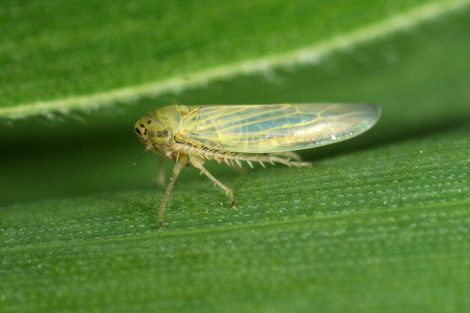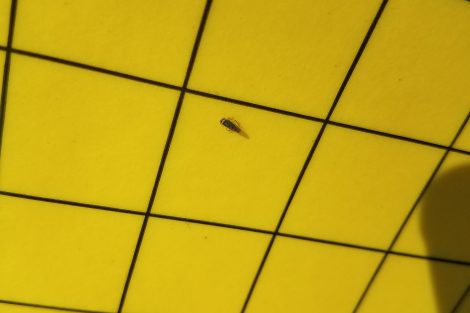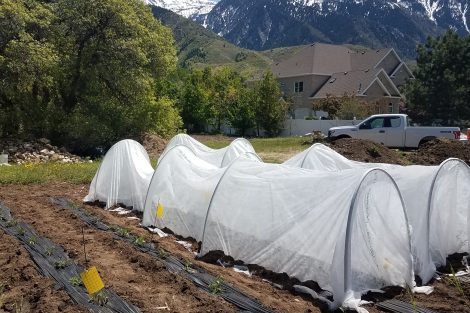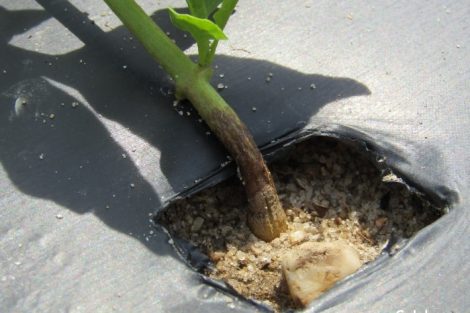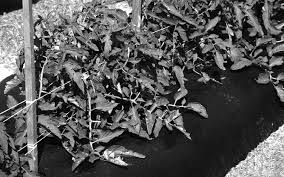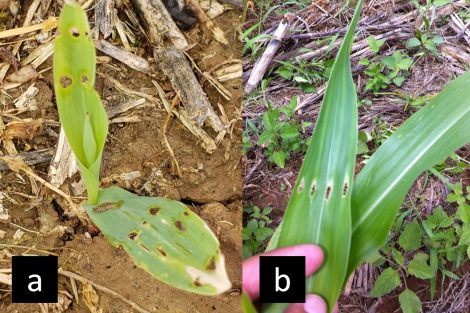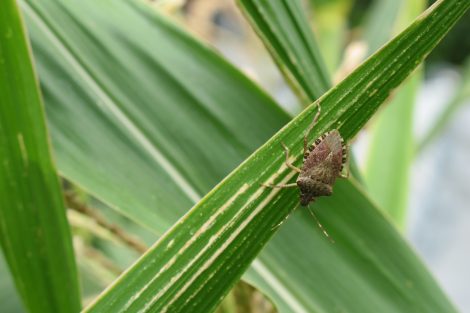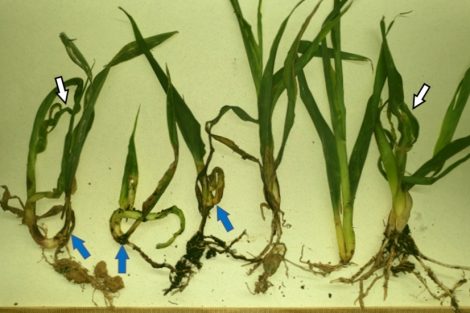In this Issue:
- Beet Leafhoppers: A common threat during the first 6-8 weeks of planting.
- Heat Injury: Transplants are susceptible to being burnt on their stems and foliage if they come into contact with black plastic mulch.
- Stink Bugs: Stink bugs can potentially cause damage to young corn stands.
Beet Leafhoppers (Circulifer tenellus)
Overview
Beet leafhoppers are prevalent throughout the western United States. Their annual movement follows the wind currents from desert areas in New Mexico and Arizona up into Colorado and Utah. Adults have 3 mm wedge-shaped bodies with wings. Their summer colors can range from a pale green, grey, to tan. During the winter and early spring, they will appear darker in color. In Utah, beet leafhoppers can have 1-2 generations in the spring months (when they are mainly a threat). Then an additional 2-3 generations throughout the summer. Depending on the temperature, females can lay up to 200 eggs. These white/yellow eggs are elongated and slightly curved. Nymphs develop through 5-6 instars, they’re spotted with black, red, and brown coloring on their thorax and abdomen.
Damage
Crops are most susceptible in the springtime when the weeds begin to dry up and the pests migrate toward other host crops. Both nymphs and adults have piercing-sucking mouthparts which can causes host plants to shrivel and “burn” under major infestations. Beet Leafhoppers are one of the primary vectors for Curly Top Virus (Curtovirus). CTV is unpredictable but widespread across Utah and is especially threatening to tomato production. Symptoms can include twisted-curled leaves, dark purple veins (not to be confused with phosphorus deficiency), and yellowing of mature leaves. Less common host crops include beets, beans, peppers, cucurbits, and several weed species.
Management
- Use yellow sticky traps to monitor beet leafhopper populations.
- Exclude Beet Leafhoppers (and other potential pests) by using floating row covers.
- Shade your tomato and pepper plants.
- Destroy and remove all plant debris and residue at the end of the growing season.
- “Hide” susceptible plants among resistant plants.
- Beet Leafhopper insecticides registered for commercial use in Utah:
| Active Ingredient | Brand Name | Mode of Action | Residual Days |
Other Notes |
| Carbaryl | Carbaryl, Sevin |
1A |
3 |
|
| Dimethoate | Dimate 4E, Dimethoate |
1B |
6-7 |
Not for Eggplants |
| Endosulfan | ThionexR |
2A |
Not for Eggplants |
|
| Alpha-cypermethrin | FastacR |
3 |
3 |
|
| Bifenthrin + zeta-cypermthrin | HeroR, SteedR |
3 |
3 |
|
| Deltamethrin | Delta GoldR |
3 |
5 |
|
| Fenpropathrin | DanitolR |
3 |
7 |
|
| Gamma-cyhalothrin | DeclareR |
3 |
5 |
|
| Lambda-cyhalothrin | LambdaR, ParadigmR, SilencerR |
3 |
5 |
|
| Pyrethrins | PyganicOB |
3 |
||
| Zeta-cypermethrin | MustangR |
3 |
7 |
|
| Pyrethrin+piperonyl butoxide | Evergren |
3 |
3 |
|
| Zeta-cypermethrin + avermectcin BI | GladiatorR |
3/6 |
7 |
|
| Beta-cyfluthrin + imidacloprid | Leverage 360R |
3/4A |
7 |
|
| Lambda-cyhalothrin + imidacloprid |
KilterR |
3/4A |
5 |
|
| Lambda-cyhalothrin +thiamethoxam | EndigoR |
3/4A |
5 |
|
| Bifenthrin + abamectin | AthenaR |
3/6 |
10 |
|
| Lambda-cyhalothrin +chlorantraniliprole | Viliam XpressR |
3/28 |
5 |
|
| Pyrethrins + azadirachtin | AzeraOB |
3/UN |
5-7 |
|
| Clothianidin | Belay |
4A |
7 |
|
| Imidacloprid | Admire Pro, Couraze, Marathon |
4A |
5 |
|
| Thiamethoxam | Actara, Flagship, Platinum |
4A |
5 |
|
| Spirotetramat | Kontos |
23 |
7 |
|
| Chlorantraniliprole+thiamethoxam | Durivo, Voliam Flexi |
28/4A |
One application per/season |
|
| Beauveria bassiana GHA | BotanigardB |
NC |
2-5 |
No tomato |
| Kaolin | SurroundO |
NC |
5 |
|
| Potassium salts of fatty acids (insecticidal soap | M-Pede |
NC |
7 |
|
| Sodium tetraborohydrate decahydrate | Prev-AM |
NC |
7-10 |
|
| Sucrose octanoate | SucraShield |
NC |
- Beet Leafhopper insecticides registered for home use in Utah:
|
Active Ingredient |
Brand Name | Mode of Action | Residual Days |
Other Notes |
| Malathion | Bonide Malathion, Ortho Max Malathion |
1B |
5 |
|
| Bifenthrin | Binide Eight Flower and Vegetable Granules, Monterey All Natural Mite & Insect Control, Ortho Bug-B-Gon Max |
3 |
7 |
|
| Esfenvalerate | Monterey Bug Buster II |
3 |
||
| Lambda-cyhalothrin |
Spectracide Triazicide |
3 |
7 |
|
| Permethrin | Bayer Complete Insect Dust, Bonide Eight Vegetable Fruit and Flower |
3 |
3 |
|
| Zeta-cypermethrin | GardenTech Sevin |
3 |
14 |
|
| Pyrethrins + piperonyl butoxide | Bonide Pyrethrin Garden Insect Pray^B, GardenTech Worry Free Insecticide and Miticide |
3 |
3 |
|
| Pyrethrin + canola oil | Monterey Tae Down Garden Spray |
3/NC |
Only tomatoes | |
| Pyrethrin + sulfure | Bayer Natria Insect, Disease and Mite Control, Bonide Tomato and Vegetable 3 in 1 |
3/M2 |
7 |
Not eggplants |
| Acetemipirid | Ortho Flower, Fruit, and Vegetable |
4A |
7 |
|
| Capsaicin and related capsaicinoids | Bonide Hot Pepper Wax Insect Repellent |
NC |
||
| Oils: canola, clove, cottonseed, garlic, neem, paraffinic, peppermint rosemary | Bayer Natria Multi-insect controlO, Bonide All Seasons Horticultural and Domant SprayO |
NC |
||
| Potassium salts of fatty acids (insecticidal soap) | Bayer NatriaB, Safer Insecticidal SoapB, Natural GuardB |
NC |
7 |
Additional Resources
Beet Leafhoppers (Utah Vegetable Production & Pest Management Guide)
Curly Top Virus (Utah Vegetable Production & Pest Management Guide)
Curly Top Virus (USU Factsheet)
Historical Beet Leafhopper Research in Utah (over 100 years old)
Heat Injury on Transplants
Overview
Black plastic mulch is a successful method of weed control and water retention in commercial vegetable production. However, one disadvantage is that it can contribute to heat injury on new transplants. This occurs on clear sunny days that then allow the surface of the black mulch can exceed 130 degrees Fahrenheit.
Damage
When the lower leaves or stem of transplants come into contact with the black plastic mulch at high temperatures this can cause burning to the foliage or stem. This is an abiotic factor and shouldn’t be confused with any insect or disease symptoms.
Management
- Depending on the extent of heat injury, replanting might be necessary.
- Reduce risk by improving the contact between the soil and plastic mulch.
- Harden off transplants so they will be more tolerant to heat injury.
- Holes on plastic should be round and even, and transplants should be placed to avoid plant contact with the plastic.
Additional Resources
Use of Plastic Mulch for Vegetable Production (USU Factsheet)
Heat Injury with Plastic Mulches (Michigan State Extension)
Plasticulture for Commercial Vegetables (North Carolina State Extension)
Plasticulture Troubleshooting (Delaware Extension)
Vegetable Transplant Production (USU Factsheet)
Potential Stink Bug Damage in Sweet Corn
Overview
Young corn seedlings emerging in the late spring and early summer can be at risk to stink bug damage. Corn species are a part of the wide range of hosts targeted by stink bugs here in Utah. Stink bug species in Utah include the Brown-Marmorated, Brown, Vonchuela, Consperse, Green, One-spotted, Say’s, and Uhler. Adults are shield-shaped and lay barrel-shaped egg clusters on host plants leaves. There are typically 2-3 generations within a year.
Damage
In Utah, there has been no reported stink bug damage to seedling corn thus far. However, signs have been reported elsewhere in the country. Knowing the signs can be helpful in assisting to identify stink bugs in the field or garden. Stink bug adults and nymphs have piercing-sucking mouthparts which puncture the stems, leaves, or apical meristems of corn plants. The stink bugs will then inject enzymes into the plant to aid their digestion and fluid removal. Though they can target corn seedlings, stink bugs are more a threat to other host crops during the summer and fall in Utah.
Management
- Attract and conserve natural enemies to stink bugs such as birds, spiders, wheel bugs, assassin bugs, parasitic wasps, and even predatory wheel bugs.
- Monitor for stink bug populations by visual inspection and traps.
- In small sites, hand remove the stinkbugs and discard them into soapy water.
- Remove all weeds that grow near field or garden borders to decrease stink bug attraction.
- Insecticide options are available for stink bugs, but always read the label to ensure they’re safe to use on your specific crop.
Additional Resources
Stink Bugs on Corn (Purdue Extension)
Scouting and Managing Stink Bugs in Seedling Corn (North Carolina State Extension)
Damage by Stink Bugs Observed in Seedling Corn (Kentucky Extension)

